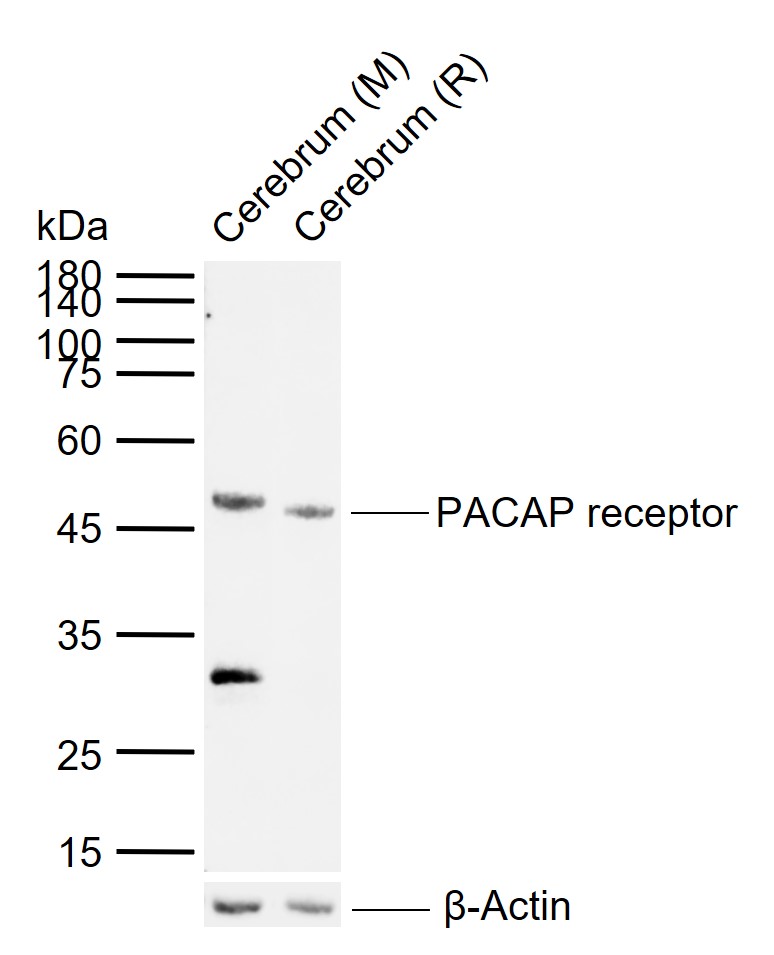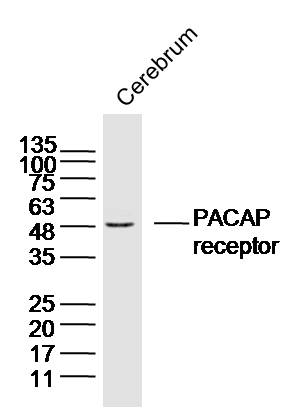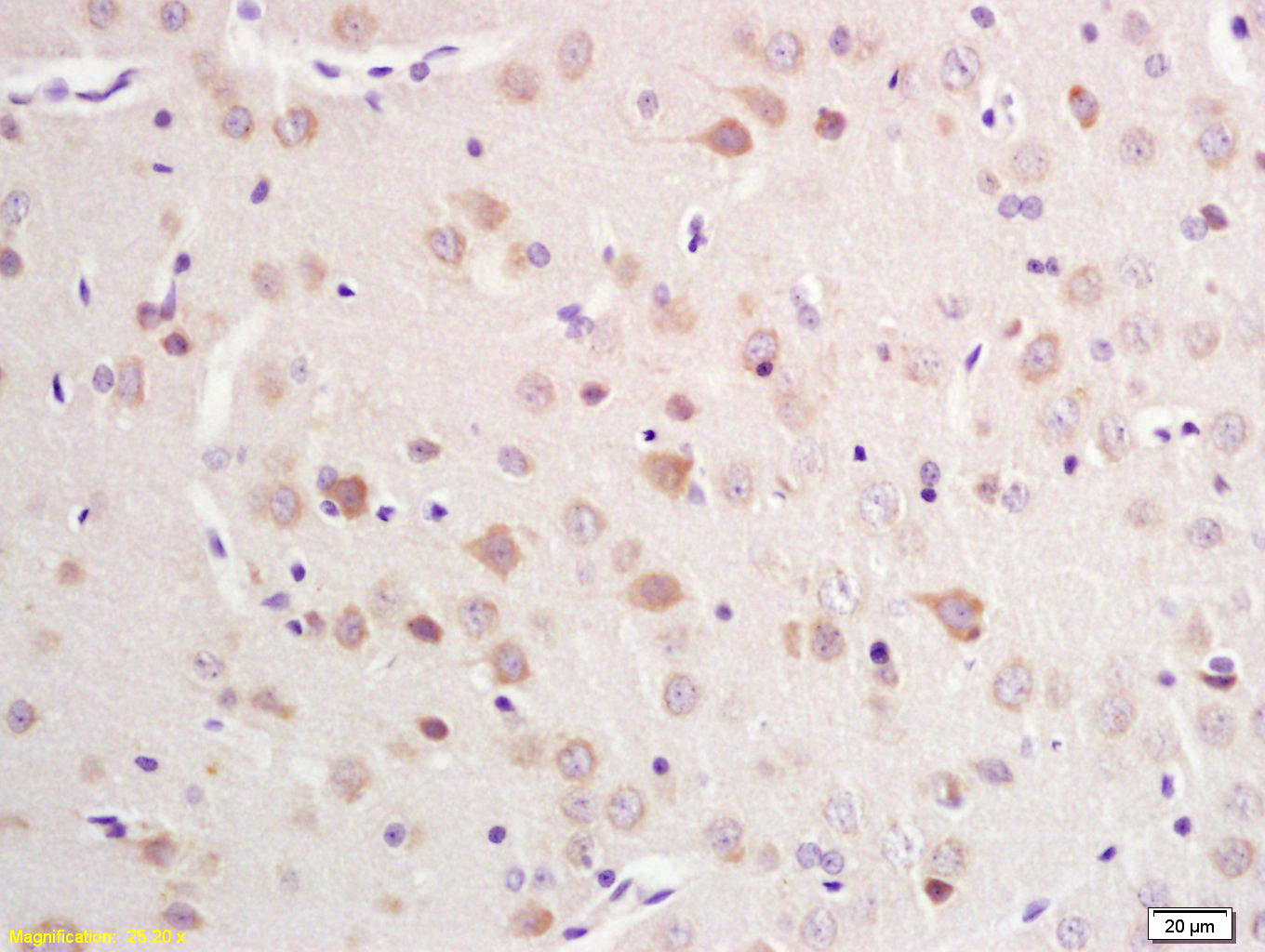
Rabbit Anti-PACAP receptor antibody
ADCYAP1 R1; ADCYAP1R 1; PACAP-R1; adenylate cyclase activating polypeptide 1 (pituitary) receptor type 1; PAC 1; PAC1; PAC1R; PACAP R 1; PACAP1 R; PACAPR; PACAPRI; Pituitary adenylate cyclase activating polypeptide 1 receptor type I Hiphop; Pituitary aden
View History [Clear]
Details
Product Name PACAP receptor Chinese Name 腺苷酸环化酶激活肽受体1抗体 Alias ADCYAP1 R1; ADCYAP1R 1; PACAP-R1; adenylate cyclase activating polypeptide 1 (pituitary) receptor type 1; PAC 1; PAC1; PAC1R; PACAP R 1; PACAP1 R; PACAPR; PACAPRI; Pituitary adenylate cyclase activating polypeptide 1 receptor type I Hiphop; Pituitary adenylate cyclase activating polypeptide receptor; Pituitary adenylate cyclase activating polypeptide type I receptor precursor; PACR_HUMAN. literatures Research Area Cell biology immunology Neurobiology The cell membrane受体 G protein-coupled receptor Immunogen Species Rabbit Clonality Polyclonal React Species Mouse, Rat, (predicted: Human, ) Applications WB=1:500-2000 ELISA=1:5000-10000
not yet tested in other applications.
optimal dilutions/concentrations should be determined by the end user.Theoretical molecular weight 51kDa Cellular localization The cell membrane Form Liquid Concentration 1mg/ml immunogen KLH conjugated synthetic peptide derived from the middle of human PACAP R1: 251-330/468 Lsotype IgG Purification affinity purified by Protein A Buffer Solution 0.01M TBS(pH7.4) with 1% BSA, 0.03% Proclin300 and 50% Glycerol. Storage Shipped at 4℃. Store at -20 °C for one year. Avoid repeated freeze/thaw cycles. Attention This product as supplied is intended for research use only, not for use in human, therapeutic or diagnostic applications. PubMed PubMed Product Detail Pituitary adenylate cyclase-activating polypeptide (PACAP) is a neuropeptide belonging to the vasoactive intestinal polypeptide/glucagon/ secretin family. It is widely distributed in the body, and a variety of biological actions have been reported. Recent studies have shown that there is a family of PACAP receptors (PACAPRs), and two members of this family have been identified. This is a receptor for PACAP-27 and PACAP-38. The activity of this receptor is mediated by G proteins which activate adenylyl cyclase. May regulate the release of adrenocorticotropin, luteinizing hormone, growth hormone, prolactin, epinephrine, and catecholamine. May play a role in spermatogenesis and sperm motility. Causes smooth muscle relaxation and secretion in the gastrointestinal tract (By similarity). Belongs to the G-protein coupled receptor 2 family.
Function:
This is a receptor for PACAP-27 and PACAP-38. The activity of this receptor is mediated by G proteins which activate adenylyl cyclase. May regulate the release of adrenocorticotropin, luteinizing hormone, growth hormone, prolactin, epinephrine, and catecholamine. May play a role in spermatogenesis and sperm motility. Causes smooth muscle relaxation and secretion in the gastrointestinal tract.
Subunit:
Interacts (via N-terminal extracellular domain) with ADCYAP1.
Subcellular Location:
Cell membrane; Multi-pass membrane protein.
Tissue Specificity:
Most abundant in the brain, low expression in the lung, liver, thymus, spleen, pancreas and placenta.
Similarity:
Belongs to the G-protein coupled receptor 2 family.
SWISS:
P41586
Gene ID:
117
Database links:Entrez Gene: 117 Human
Entrez Gene: 11517 Mouse
Omim: 102981 Human
SwissProt: P41586 Human
SwissProt: P70205 Mouse
Unigene: 377783 Human
Unigene: 44245 Mouse
Unigene: 88408 Rat
Growth factors and hormones( Growth Factor and Hormones)
PACAP 受体分为两个亚型,PACAP-1型受体对PACAP是特异性的,与PACAP的亲和力比VIP高100-1000倍,PACAP-II型受体与PACAP和VIP的亲和力相似,对二者无选择性。此抗体即为前者。Product Picture
Lane 1: Mouse Cerebrum tissue lysates
Lane 2: Rat Cerebrum tissue lysates
Primary: Anti-PACAP receptor (SL0198R) at 1/1000 dilution
Secondary: IRDye800CW Goat Anti-Rabbit IgG at 1/20000 dilution
Predicted band size: 51 kDa
Observed band size: 47 kDa
Sample:Cerebrum (Mouse) Lysate at 40 ug
Primary: Anti-PACAP receptor(SL0198R)at 1/300 dilution
Secondary: IRDye800CW Goat Anti-Rabbit IgG at 1/20000 dilution
Predicted band size: 51kD
Observed band size: 48kD
Tissue/cell: rat brain tissue; 4% Paraformaldehyde-fixed and paraffin-embedded;
Antigen retrieval: citrate buffer ( 0.01M, pH 6.0 ), Boiling bathing for 15min; Block endogenous peroxidase by 3% Hydrogen peroxide for 30min; Blocking buffer (normal goat serum,C-0005) at 37℃ for 20 min;
Incubation: Anti-PACAP R1/PACAP receptor 1 Polyclonal Antibody, Unconjugated(SL0198R) 1:200, overnight at 4°C, followed by conjugation to the secondary antibody(SP-0023) and DAB(C-0010) staining
References (0)
No References
Bought notes(bought amounts latest0)
No one bought this product
User Comment(Total0User Comment Num)
- No comment





 +86 571 56623320
+86 571 56623320
 +86 18668110335
+86 18668110335

